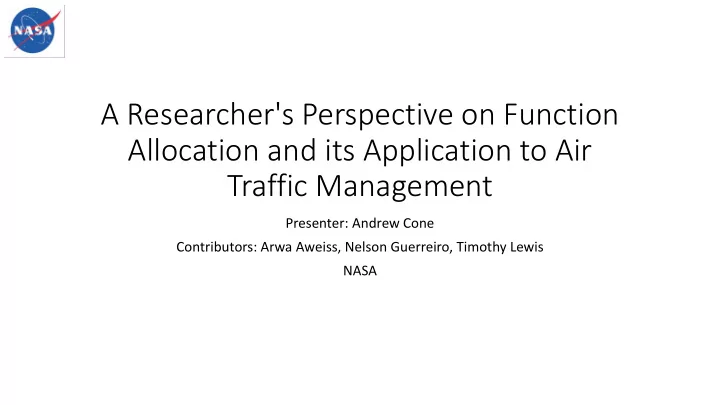

A Researcher's Perspective on Function Allocation and its Application to Air Traffic Management Presenter: Andrew Cone Contributors: Arwa Aweiss, Nelson Guerreiro, Timothy Lewis NASA
2
Past Research Focus Technologies Algorithms 3
Air/Ground, Human/Automation Design Space Airborne Concepts of Operation Ground Human Fully Controlled Autonomous 4
Breakdown of Single Concept of Operations Airborne Weather avoidance Scheduling Merging/ Conflict Conflict Spacing resolution detection Ground Human Fully Controlled Autonomous 5
What is the problem? Airborne ? Ground Human Fully Controlled Autonomous 6
Separation Assurance Function Allocation Function Allocation: Of all the necessary functions comprising a Separation Assurance system, how and where should the functions be performed? Current Research Goal: Make recommendations about the allocation of en route separation assurance functions in the future National Airspace System to humans/automation/ground-based/airborne agents 7
How does Function Allocation help? • The design space is broken up into a series of key questions • 6 questions covering the air/ground performance studies • 4 questions covering the human/automation performance studies • Each question addressed individually by a team of researchers • Recommendations will be in the final roll-up 8
Function Allocation Questions Airborne/Ground Human/Automation • Surveillance, state information, intent • Controller Separation Assurance quality effect on conflict detection functions in future National Airspace System • Overall effect of level of coordination • Flight crew Separation Assurance and information availability functions in future National Airspace • Level of coordination effect on arrival System merging and spacing • Separation Assurance responsibility • Distributing and layering Separation transfer between humans, pilots, and Assurance functions automation • Effect of resource constraints on • Explore human compensation options throughput for imperfect automation in • Effect of weather information and Separation Assurance function allocation on efficiency 9
Overall System Level Challenges • To make recommendations, a broad knowledge base is needed • Traditional studies that examine individual “point” concepts will not efficiently cover the test area • Identifying key variable interactions when comparing configurations is important and difficult • Some variables are continuous, others are binary or have specific settings • Different analysis approaches needed to examine different types of variables • Identifying meaningful results is more complicated • Individual study results will be focused on trends and identifying characteristics of different test configurations • Incomplete results or results that do not project to a larger system can make roll-up more difficult 10
Parametric Studies Example How does surveillance, flight state information, and trajectory intent quality affect conflict detection performance? • Conflict detection carried out by automation for this study • Quality and content of input data expected to be primary cause of performance differences • Quantity of shared intent data • Quality of shared intent data • Quality of surveillance data ? 11
Parametric Studies Example How does surveillance, flight state information, and trajectory intent quality affect conflict detection performance? • Determine known variables based on system requirements or hardware limitations • Maximum missed detection rate • Surveillance range • Conflict detection cycle rate • Quality of intent data shared • Results can be used to refine requirements, or zero in on ranges for testing for other variables • Conflict detection time horizon • Expected false alert rate 12
Parametric Studies Example How does surveillance, flight state information, and trajectory intent quality affect conflict detection performance? • Determine known variables based on system requirements or hardware limitations • Maximum missed detection rate • Surveillance range • Conflict detection cycle rate • Quality of intent data shared • Results can be used to refine requirements, or zero in on ranges for testing for other variables • Conflict detection time horizon • Expected false alert rate 13
Non-Parametric Studies Example What is the effect of the level of coordination during arrival merging and spacing on schedule conformance and stability? • Conflict detection and resolution carried out by automation for this study • Multiple variables have discrete settings • Location of scheduling algorithm • Location of agent responsible for managing arrivals • Intended output will be characteristics of each configuration tested • Sensitivity to primary variables • Key contributors to performance differences 14
Non-Parametric Studies Example What is the effect of the level of coordination during arrival merging and spacing on schedule conformance and stability? • Looking for characteristics of: • Configuration – Caused by functional differences between concepts • Simulation – Caused by simulation framework • Algorithm – Caused by algorithm properties • Traditional metrics (i.e. delay, number of maneuvers) should not be used for direct comparisons • “Fair” comparisons difficult • Goal of individual studies not to pick a best solution 15
Breaking Down Comparison Metrics Concept A Concept B delay/maneuver 40 65 10 – Algorithm differences concept A vs B Δ delay = 25 8 – Simulation implementation concept A vs B presence of remainder points to Functional differences between concept A vs B 16
Breaking Down A Single Metric Identify root causes for key features of each metric 17
Breaking Down A Single Metric Identify root causes for key features of each metric Root causes related to algorithms may be addressable with code adjustments, while those related to the simulation may not be 18
Summary • The goal of current Function Allocation research in Air Traffic Management is to explore the design space of a future Separation Assurance system and provide recommendations to decision makers • Design space broken up into 10 questions: 6 related to the air/ground axis and 4 related to the human/automation axis • Researchers need to separate characteristics of the configuration, simulation, and algorithms as much as possible • Individual study outputs need to be presented in a way that can be rolled-up with results from other studies into a single reference 19
Recommend
More recommend